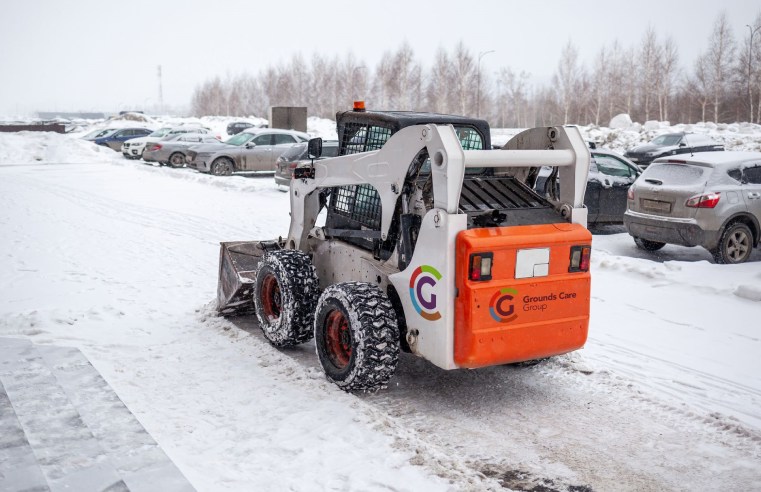Adam Brindle, MD of the Grounds Care Group discusses winter gritting in the era of climate change.
Over the past 12 months our planet has borne witness to a relentless barrage of catastrophic weather events that have left a trail of destruction, loss, and displacement across the globe. From raging wildfires to devastating floods, extreme heatwaves, and powerful hurricanes, these events serve as a stark reminder of the escalating climate crisis and its undeniable impact on our environment, communities and businesses.
Researchers predict that these extreme weather events will become the new norm as the UK will experience more frequent and pronounced fluctuations in temperature due to climate change. Winters, once a predictable period of cold, are now poised to become more intense, with sudden plunges in temperature that may catch businesses off guard.
One of the challenges of these dramatic climate events is the way in which the modern FM can adapt to delivering essential services like winter maintenance and gritting.
Changing weather patterns and the art of prediction
The changing climate has ushered in a new era of uncertainty when it comes to predicting weather patterns. Traditionally, the UK has enjoyed a relatively stable climate, allowing businesses to anticipate and prepare for winter conditions. However, the influence of climate change has introduced an element of chaos into this equilibrium.
In the past, meteorologists could rely on historical data and established weather patterns to make reasonably accurate forecasts. However, the rising temperatures and shifting climate dynamics have thrown these patterns into disarray. This climate unpredictability challenges the traditional forecasting methods relied upon by winter gritting operations.
There is a fine line between knowing when to grit, and when not to, and getting it wrong could be a costly exercise. Businesses can now rely on very accurate regional forecasting services that can tell you when a bad frost is likely. Rain and snow can also have a big impact on the effect of gritting: better weather awareness and timing gritting around when precipitation is expected is hugely important.
Applying the science will make sure that there are no nasty surprises and will also prevent you from wasting man-hours and grit supplies when the weather is bad. This focus on reducing waste is also why the leading professional contractors use software directly linked to weather data to initiate gritting jobs only when needed as it can bring down the overall cost of winter maintenance.
Adapting gritting strategies for a changing climate
Amid the whirlwind of changing climate dynamics, the importance of robust winter gritting strategies cannot be overstated. UK businesses are finding themselves at a crossroads where effective winter maintenance is not just a matter of convenience; it's a strategic necessity.
Proactive winter gritting doesn't just prevent slips and falls on icy surfaces; it's a vital component of business continuity. Supply chains, employee productivity, and customer experiences all hinge on a seamless response to winter weather challenges.
Getting the winter gritting strategy right involves putting in place a reliable winter maintenance plan, and embracing data-driven approaches. Advanced weather forecasting technologies, combined with real-time monitoring, provide businesses with the tools to make informed decisions. These insights allow for the allocation of resources where they are needed most, minimising downtime and ensuring the safety of employees, customers and site visitors.
The vital role of technology
As the traditional methods of predicting weather patterns face increasing limitations due to the unpredictable impacts of climate change, cutting-edge technology is emerging as a powerful ally. Advanced weather forecasting models, driven by complex algorithms and powered by immense computational capabilities, are now capable of simulating the intricate interactions that govern our atmosphere. These models take into account a myriad of variables, including temperature gradients, wind patterns, and moisture levels, resulting in more accurate predictions that factor in the effects of climate change.
While gritting itself seems low tech on the surface, virtually everything around the delivery of the service itself is being transformed by technology. Every industry today is becoming digitised and gritting is no exception. Arguably, some winter maintenance service providers have actually been ahead of the curve in providing a data driven service, as decisions as to when and how to grit sites has for some time been guided by increasingly accurate weather data. For example, the sector has adopted technology and location intelligence to automate service activation and scheduling whenever zero ground temperatures are forecast and the precision of this automated decision making has only increased.
The benefits of such an approach include ensuring a consistent and accurate response to unexpected bad weather, scheduling vehicle routes and service delivery for best results (i.e. avoiding spreading grit at a site just before heavy precipitation), and preventing wasteful gritting on days when it isn’t needed. This last factor is particularly attractive to site managers as only gritting when needed delivers savings that add up considerably over the course of a winter.
Technological developments have also transformed the extent of service level guarantees that winter maintenance companies can provide. Mobile technology helps everyone in this respect: Operators have access to customer site plans and instructions on PDAs and this also cuts their admin by streamlining service delivery and the process of reporting. And when an operator checks in to a site using a mobile device, his vehicle also logs his attendance and the time of the visit. All of this data is available to customers online in real-time, so they know exactly when and where a site has been gritted. Crucially, this information provides peace of mind that any risk is being effectively managed in the best possible way.
Conclusion
The intersection of climate change and winter gritting represents a significant challenge that demands innovative solutions and adaptable strategies. The days of relying solely on historical patterns for weather predictions are fading, ushering in an era where the only constant is change itself. As our climate continues to evolve, the importance of sustainable and dynamic winter maintenance approaches cannot be overstated. By embracing new technologies, data-driven decision-making, and collaborative efforts, organisations can navigate the uncertainties of climate change and ensure safer, fully compliant workplaces.






































